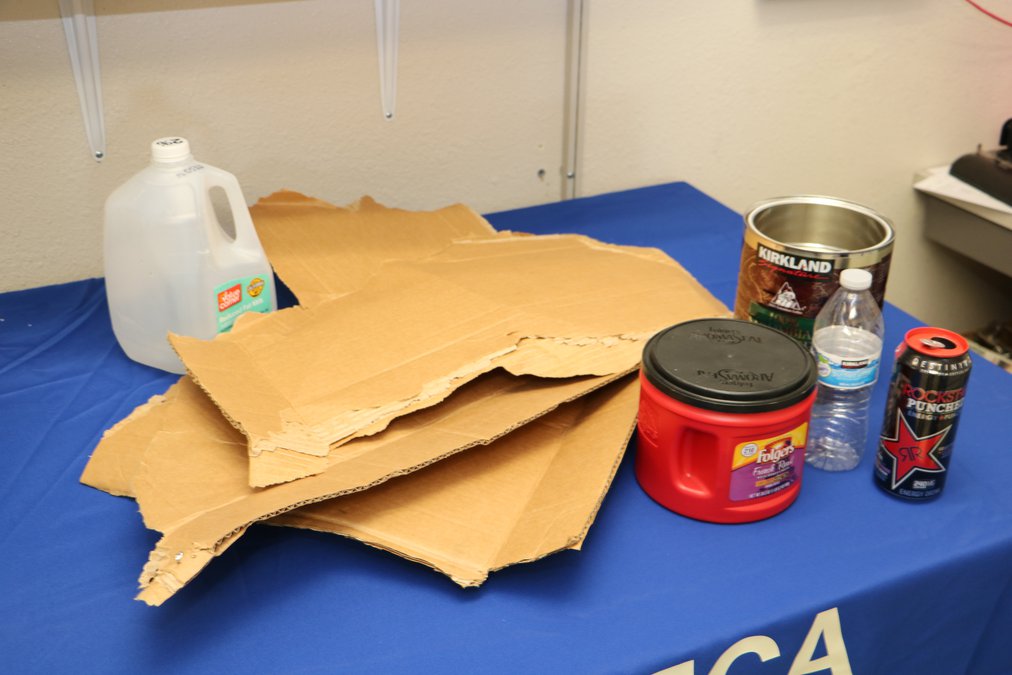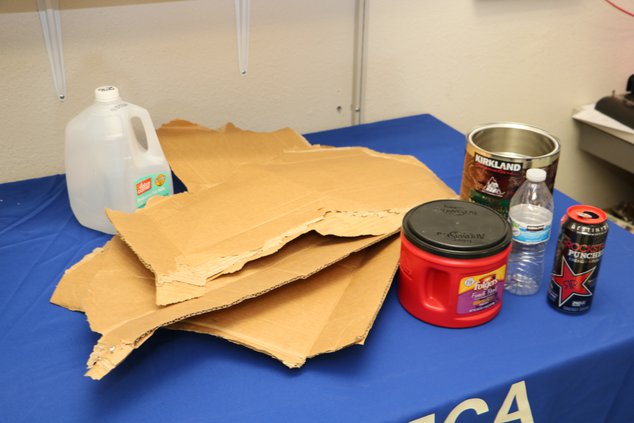Once you are finished reading this newspaper and no longer have a use for it, if you are a Manteca resident you place it in your blue cart for recycling along with glass bottles, cereal cartons, magazines, and junk mail.
Starting Dec. 1 doing so is prohibited. That means no paper of any kind, glass bottles, and cartons households and business have recycled for years can be placed in recycling carts for the city to pick up. The same goes for items already banned such as food, garbage, plastic bags, Styrofoam, light bulbs and such. Then in January the city will start inspecting what is in blue carts. If any of the banned items are in them, the cart will not be dumped. If that is still happening in February, the city will start removing the blue recycling containers from offending households and businesses.
All types of paper, cartons, and glass bottles that have been faithfully recycled by Manteca residents for more than 25 years will have to be placed in the brown garbage cart.
It is a move Manteca is being forced to make in a bid to avoid a hefty rate increase after oversea buyers — primarily China — in March stopped buying shiploads of used paper, cartons, and glass bottles as recyclables collected from American municipalities had more than 5 percent contamination with garbage and other recyclables. Such contamination not only rendered containers filled with recyclable items useless, but it forced foreign companies to landfill the items instead of recycling them into new products.
Manteca has never charged ratepayers for the blue recycling carts. That’s mainly because the firm that they shipped the collected recyclables to was able to sell them. That’s no longer the case. As a result collected recyclables the city used to pay nothing to get rid of are now costing $52 a ton to landfill — the same cost of land filling garbage. That cost was never figured into the solid waste rates.
If the city didn’t come up with a solution and continued to bury recyclables they would have been forced to add charges for the blue recycling carts that have essentially been reduced to garbage carts by implementing charges that could have rivaled what is now charged for the brown carts. Given recycling carts are collected just every two weeks that would have been upwards of $14.24 for a 32 gallon cart, $15.14 for a 64-gallon cart, and $15.98 for a 96-gallon cart.
The solution leaves only four items that can be placed in the blue carts:
Corrugated cardboard that is clean and flattened.
Plastic containers (No. 1 and No. 2) such as those used for milk.
Empty metal containers, primarily food cans.
CRV redemption bottles and cans.
Those are the only four recyclable items that there are still concerns that will purchase them.
What the move may
force ratepayers to do
The switch in recycling rules is likely to result in a bump in monthly solid waste bills if a homeowner or business isn’t able to work all of the paper, CRV containers, cereal boxes and egg cartons as well as non-plastic milk cartons and such, as well as metal containers they usually get rid of every other week in a blue cart on a weekly basis mixed with garbage they are already placing in brown carts.
In making an educated guess, Solid Waste Manager Rexie LeStrange said as many as half of the city’s 23,000 plus household solid waste customers may have to trade up for a larger brown cart or get an additional brown cart if they are already maxed out with a 96-gallon cart.
Currently the monthly charge for a 32-gallon brown cart is $28.48, a 64-gallon cart is $30.28, and a 96-gallon cart $31.97. To go from a small to medium cart would be an additional $1.80 a month and from the medium to large is $1.69 a month. If someone went from a small to large cart the monthly increase would be $3.49 a month.
When compared to what the city could be forced to charge if they can’t find a way to stop burying all recyclables regardless if any of them have a value due to the high cost of sorting them which still means what can’t be recycled any longer would have to be buried, the uptick in monthly charges by switching out to a larger can would be significantly less.
There are three caveats, however.
Someone who can’t fit the items that are no longer recyclable in their 96-gallon brown carts would be forced to add a second brown cart. Given it wouldn’t make a sense to get the smallest cart given the cost and volume that means they will see a $30.28 a month jump in their solid waste bill if they add a 64-gallon cart of $31.97 if they add a second 96-gallon cart. The latter would take their monthly solid waste bill from $31.97 to $63.94.
Manteca is still in the process of implementing garbage rate increases adopted in 2016 in phases with a price hike each Jan. 1 through 2021. That would take the 32-gallon rate now at $28.48 a month ultimately up to $30.67 a month by 2021, the 65-gallon rate now at $30.28 a month up to $32.61 by 2021, and the 96-gallon rate now at $31.97 a month up to $34.33 a month by 2021.
Switching out to a larger or smaller size will cost you $51.75 a cart.
The solid waste customer expected to experience the biggest increase in costs is the Manteca Unified School District.
“They (the schools) recycle a tremendous amount of paper,” LeStrange said.
It will be tough to
get away with not
following new rules
Manteca has a system that catches those who now contaminate blue carts with garbage.
Drivers have cameras on their trucks that allow them to see what is being dumped. They can also be alerted by “noises” a dump from a blue cart may make that signals it contains garbage. When that happens, the driver immediately radios in the address to solid waste dispatch that logs it. The driver then places a warning sticker on the blue cart.
Two weeks later the address has been flagged when he starts his rounds. The driver at flagged addresses will get out, inspect the cart contents, and if it is contaminated will not dump the contents and place a sticker on the cart telling the resident why it wasn’t collected. If two weeks later the recyclables are still contaminated, the city will seize the blue cart.
Next month the city will use California Conservation Corps workers who will blanket the city on recycling collection days to apply stickers to the blue carts that show what can and can’t be placed in them going forward. The CCC workers in January will inspect blue cart contents. If they aren’t complying with the new rules, they won’t be dumped, and a sticker will be placed on them telling the customer why the cart wasn’t dumped. Then in February the CCC will help spot violators but by then those customers not complying will have their blue carts taken away from them.
If you think you can then dump your garbage in city trash cans such as found at parks or perhaps in a vacant lot, guess again. Solid waste crews are already dealing with that problem. Based on the addresses of mail they find in trash, they turn the names and addresses over to Manteca Police to pursue as a littering case that can carry hefty fines.
The city over the years has taken trash cans out of city parks after finding household garage dumped in them that more often than not includes identifying addresses on junk mail. That has led to fines.
Two strategies that
could avoid the
need for a larger
cart or avoid paying
more out of pocket
There are two ways you might be able to avoid the cost of switching to a larger can or to cover the cost if you do so providing you don’t currently take CRV recyclables worth a nickel apiece to redemption centers.
A two-person household that hadn’t been redeeming CRV containers and is now doing so is an example. They were putting an average of 70 CRV containers every two weeks in their 32-gallon blue cart taking up almost half the space. At a nickel apiece that is $3.50 every two weeks they were throwing away or $91 a year.
By taking them to one of two recycling centers in Manteca — one is next to the Grocery Outlet on East Yosemite Avenue and the other is in the Raley’s parking lot — you could negate the cost of a larger cart plus take a chunk out of the coming annual rate increases already in place.
The centers are open Monday through Friday during the day and require ID such as a driver’s license to redeem the CRV containers.
The move also would take away income for drug users and/or the homeless that pilfer recyclables from carts.
The other strategy is to flatten clean corrugated cardboard and take them to the drop off box at the solid waste office on Wetmore Avenue Monday through Friday from 7 a.m. to 2:30 p.m. and slip them through the slot into a recycling bin.
LeStrange said if drop offs increase additional bins will be placed outside the office.
She noted one of the biggest problems households have is disposing of Amazon and other firms’ corrugated cardboard shipping boxes.
To contact Dennis Wyatt, email dwyatt@mantecabulletin.com





